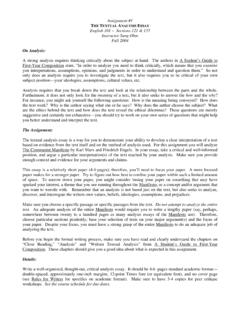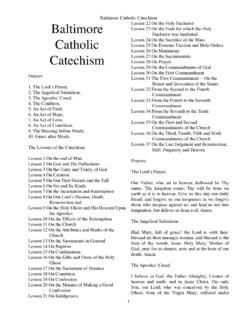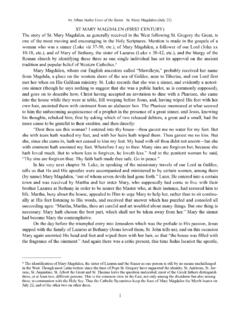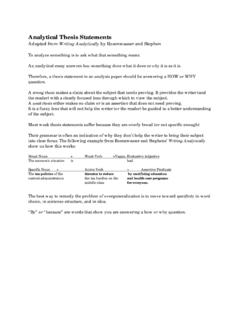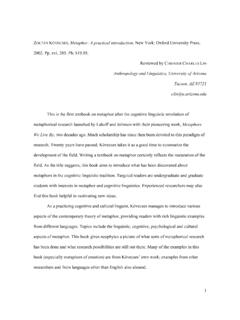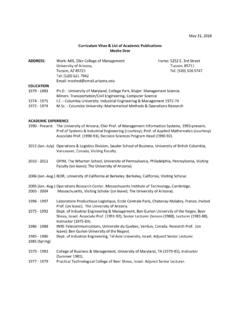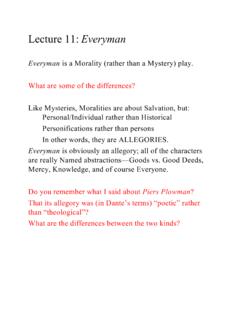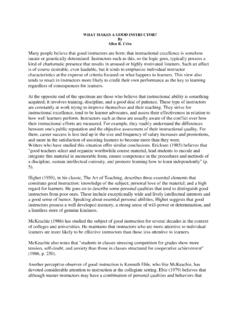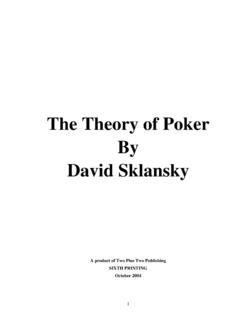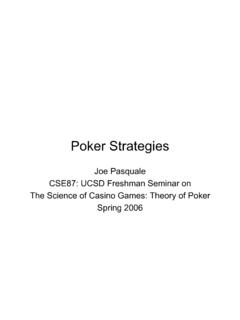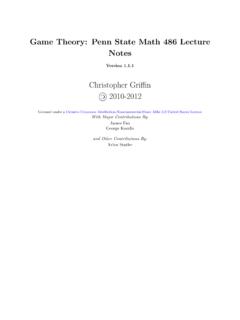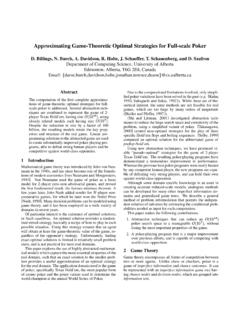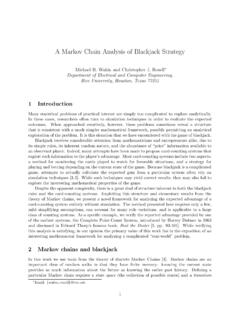Transcription of Stripped-Down Poker: A Classroom Game with ... - …
1 Economic InstructionIn this section, theJournal of Economic Educationpublishes articles, notes, andcommunications describing innovations in pedagogy, hardware, materials, andmethods for treating traditional subject matter. Issues involving the way economicsis taught are GRIMES,Section EditorStripped- down Poker: A ClassroomGame with Signaling and BluffingDavid H. Reiley, Michael B. Urbancic,and Mark WalkerAbstract:The authors present a simplified, Stripped-Down version of poker asan instructional Classroom game. Although Stripped-Down Poker is extremelysimple, it nevertheless provides an excellent illustration of a number of topics:signaling, bluffing, mixed strategies, the value of information, and Bayes s authors begin with a description of Stripped-Down Poker: how to play it, whatmakes it an interesting Classroom game, and how to teach its solution to describe how signaling, bluffing, and so forth emerge naturally as importantfeatures of the game and then discuss possible applications of this game-theoreticmodel to real-world interactions, such as litigation, tax evasion, and domestic orinternational diplomacy.
2 They also suggest modifications of the game either for usein class or as student exercises. For reference, they conclude with a brief historyof game-theoretic treatments of : Classroom experiment, game theory , signalingJEL codes: A22, C70 David Reileyis the Arizona Public Service Professor of Economics at the University of Arizona B. Urbancicis an economics PhD candidate at the University ofCalifornia, Walkeris the Eller Professor of Economics and economics departmentchair at the University of Arizona. The authors gratefully acknowledge support from NSF grant SES-0094800. They thank Martin Dufwenberg and three anonymous referees for valuable comments. Theyalso acknowledge Martin Dufwenberg for suggestions of interesting references on real-world poker,David Caballero for research assistance, Peter Winkler for a discussion about the value of informationin this game, Charlie Holt for the litigation example, and Ann Talman for her suggestion of the article 2008 Heldref PublicationsFall 2008323 Effective Classroom games should meet three criteria.
3 First, they should be sim-ple enough to be readily understood by students. Second, they should be engagingenough to capture students attention and interest. Third, they should be rich enoughnot only to describe a particular bit of theory , but also to illustrate real-world phe-nomena. Our Classroom game, Stripped-Down Poker, satisfies these three criteriaand has served as a memorable learning experience to students in our undergradu-ate economics classes on game theory . From one simple game, students can obtaininsights about signaling games , bluffing, converting from extensive to strategicform, mixed-strategy equilibrium, Bayes s Theorem, and the value of private in-formation. The game is especially timely given the recent surge of interest in pokerin popular culture: we find that a growing number of our students play poker orwatch it on THE GAMEWe like to play Stripped-Down Poker as a game between the instructor and astudent volunteer.
4 To introduce the game to your class, emphasize that you will beplaying a simplified version of poker for real money, and that the volunteer will beresponsible for paying any losses out of his or her way to heightenthe students interest level is for you to pull out money from your own , describe the nature of the game. Produce the special deck for the game,explain that it contains only four kings and four queens, and choose a student fromthe front row to verify the deck s contents to the rest of the class. (This studentmight also serve as the dealer when you actually play the game.) Explain that onlythe professor receives a card during the game; the student player does not. Aftereach player puts an ante of $1 into the pot, you (the professor) will randomly drawa card from the dealer, privately observe what it is, and decide whether to foldor to bet.
5 If you fold, the game ends, and the student wins the pot, gaining your$1 ante. When betting, place another dollar in the pot, after which the student hasthe option to either fold or call. A fold by the student ends the game, this time withyou winning the pot and gaining the student s $1 ante. Calling requires the studentto add another dollar to the pot and requires you to reveal your card. You win thepot with a king and lose the pot with a queen. The pot at this stage is $4, so thewinner nets $2 from the describing the rules, ask for a student the game 10 20times. After several rounds, you might ask for a new volunteer to play against you,either because the first volunteer no longer wants to play or because you want to giveseveral different students the opportunity to play. We find that students get activelyengaged in the game even when they are not playing: they watch attentively, shoutout advice to the student player, and generally exhibit high energy first glance, many students believe the game is fair.
6 This na ve belief servestwo important purposes. First, it produces more willing volunteers. Second, itmakes the game especially effective for teaching purposes: over the course ofrepeated play, the students begin to observe that the professor is winning moneyon average from the student volunteers. This strongly motivates the students forthe subsequent analysis of the OF ECONOMIC EDUCATIONFor maximum effect, you should attempt to play according to the equilibrium(minimax) strategy, which is to always bet when you have a king and to betone-third of the time when you have a queen. We find it best to use an externalrandomization device, such as the second hand of one s watch. For example, ifthe number of seconds in the minute is between 0 and 20, you would bet with aqueen, but if it is between 20 and 60, you would fold with a queen.
7 It is crucial thatyou look at your watch in the same way even if you have drawn a king; otherwise,glancing at your watch could serve as a tell to the students that you are holdinga queen and thus destroy your bluffing you execute this strategy correctly, the expected payoff is $1/3 to theprofessor ( $1/3 to the student), no matter what action the student chooses. After10 20 repeated rounds of the game, we recommend beginning the discussion byasking the students whether the game is fair. Some students may still think the gameis fair and that you were just lucky to have won a positive amount from the studentsafter 20 rounds. Others, after seeing the professor s profits, may now believe thegame is unfair but be uncertain about the source of the unfairness. As a cliffhanger,we often choose to schedule this game for the last 20 minutes of one class periodand challenge the students at the end of class to see if they can figure out whetherit is a fair game before the next class period, when we do a thorough EXPOSITIONYou can lead the Classroom discussion in a number of directions.
8 What youdecide to focus on depends on the level of your course and the ideas that you mostwish to illustrate by using the game. The following subsections focus on separatepotential topics. First, we help the students develop an intuitive understanding ofthe value of bluffing. Second, we show students how to represent the game in bothextensive and strategic form. Third, we solve for the mixed-strategy Nash equilib-rium of the game, with probabilistic bluffing and calling. Fourth, we illustrate theuse of Bayes s Rule by considering the probability of the professor having a king,given that she has bet. Finally, we use Stripped-Down Poker as a very simple sig-naling game to illustrate signaling equilibrium concepts. These subsections appearin a logical progression, but we have tried to make them modular. Feel free to selectthe combination of topics that most appropriately meets the needs of your Should the Players Play?
9 We prefer to start our discussion of the game by asking the students somequestions to get them thinking and to gauge their understanding. First, you mighttake a quick survey to see how many students believe that the game is fair. Youmight ask one student to explain why he thinks the game is fair and ask anotherstudent why she thinks it is unfair. Then promise the students a definitive answerin the analysis to , you can ask the students what they would do if they were playing in theprofessor s position. Many students believe that the professor s optimal strategywould be to always bet on kings and always fold on queens. When a studentFall 2008325suggests this strategy, ask the class what the student player s best response wouldbe. With a little thought, they should be able to see that if the professor alwaysfolds with queens, then the only time the student gets to move is when the professormust have a king, and therefore the student should always fold.
10 Note that with thispair of strategies, the professor earns an expected value of $0. But we have alreadyobserved through playing the game that the professor earned quite a bit of moneyfrom the students!Next, you can ask what the professor s optimal strategy would be if the studentalways folded. If there is no chance of the student calling, then there is no reason toavoid betting with queens: the professor can bluff the student into folding even ifthe professor holds a poor card. The professor s optimal strategy is thus to alwaysbet and earn $1 when the student folds. But if the professor always bets, whatis the student s optimal strategy? If the professor always bets, then the studentshould expect a 50 percent chance of a king and a 50 percent chance of a queenif he chooses to call. This means if the student calls, his expected payoff is $ contrast, if he folds, he is guaranteed to lose $1, so his optimal strategy is toalways the student always calls, then what is the professor s optimal strategy?


